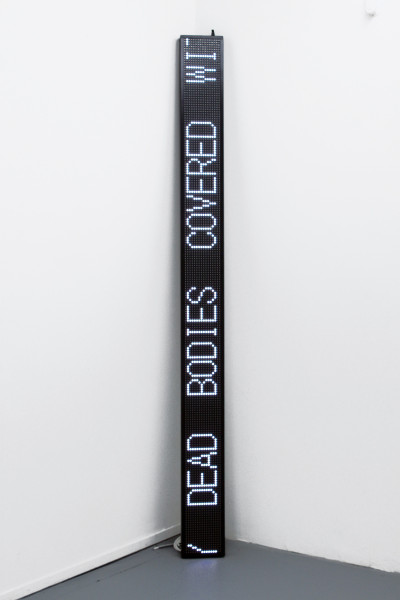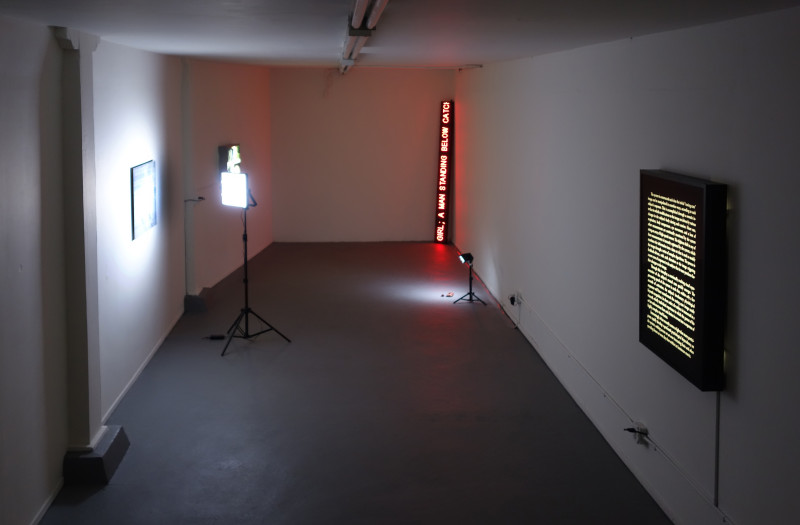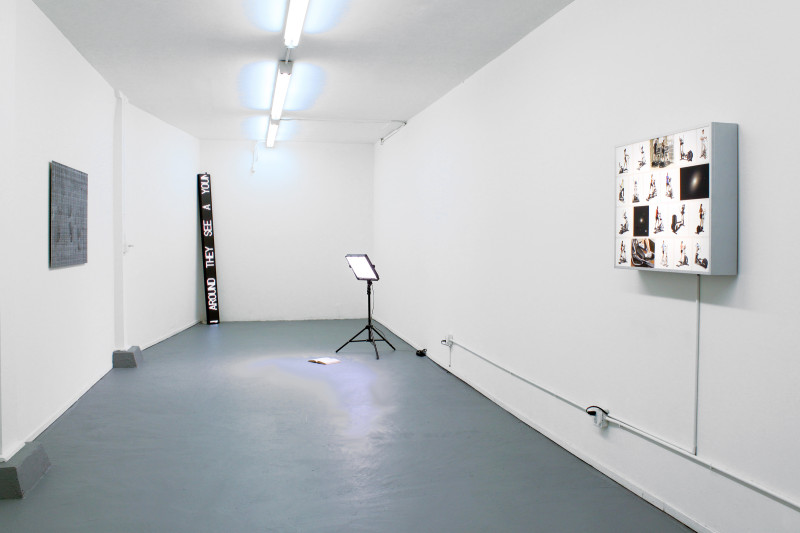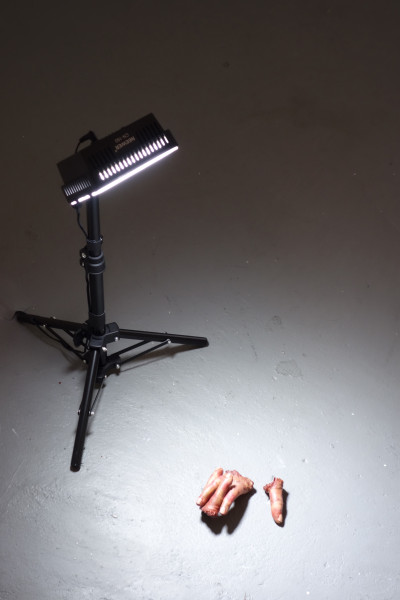“A man with a knife lunges toward a man and they fight,” scrolls across an LED sign in bold white letters, “the second man hits the first with a baseball bat and tries to inject him with a sedative, another man enters the room and is thrown into a fireplace mantel.”
This long sign is propped haphazardly against the back corner of Et al., the gallery tucked beneath a dry cleaners between the Financial District and Chinatown. Upon first read, it’s unclear what sort of account is being displayed across this single line of text — does it narrate a true crime, or perhaps a scene from a movie, novel or television show? Multimedia artist Anthony Discenza’s current solo exhibition, ‘Trouble Sleeping,’ running through Feb. 27, is an investigation into this space between subject, apparatus and meaning.

The placement of the sign itself plays up a fiction. Meant to be read horizontally, it leans on its end vertically, as if someone stashed it there but forgot to turn it off. The text in Trouble in the Interior, Part 2 continues, explaining that “a woman is shown motionless seated in a chair and we understand that she is dead,” and then, “a man with a large knife approaches her as she screams (we do not see an attack but we understand that he killed her).” The narrative is full of omniscient insertions breaking the suspension of disbelief, and jarring the reader back into a reality where they are far outside this story.
All the works in the exhibition utilize this reflexive approach, and play on the desire to locate or create a legible narrative with reminders that the works are simply that — stories. The image list discreetly reveals that the source of the text for Trouble in the Interior is an IMDB content advisory warning for an unidentified movie where scenes that might be perceived as violent, explicit, and sexual, etc. are explained in exhaustive detail. Balanced by his quirky gravitas and a measured dash of camp, Discenza pivots away from the image or subject of media, towards deliberate ruptures that expose media as the construct it is. This is the unmasking of a fiction; not the weaving of one.

Every week Discenza changes up the exhibition in ways that respond to the work previously on display. This generative project allows for each stage to respond to itself, and the gallery functions more as the artist’s studio would — privileging the work as labor that is always in process versus the primed-and-packaged finales one is used to viewing in the gallery.

Or, as Discenza suggests, Et al becomes “a laboratory,” which is an equally apt aesthetic description for the sterile visual tone of the sparse exhibition. The iterative aspect allows Discenza the opportunity to show more work over time and in turn, each piece is offered more space. At face value, the works seem disparate, like small sporadic snippets, or screen grabs, pulled together away from their original context. But over the course of all the exhibitions, the works feel like evidence or clues that he is painstakingly collecting and organizing for a reason that is becoming clearer with each show.
This is accentuated by Discenza’s use of light and lighting as an active material. He experiments with ambient lighting with all passing versions of the show: employing a darkened gallery in the first, next are standard overhead fluorescents and then even an ambient green lighting. Light boxes warmly but clinically highlight their images while freestanding lights offer forensic-like observation.

Several severed fingers sit under the harsh glare of a lone spotlight in Omission , like a crime scene in a movie. These props could be woven into any number of zombie post-apocalyptic films, but in the gallery, they feel both out of place and meticulously accurate. The campy fakeness of the horror movie prop is made more conspicuous by the presence of the light that both reveals and emphasizes its actuality as a media construction.
Et al, itself, is a unique character in Discenza’s speculative fascinations and compulsion for media and visual culture. Unlike many cookie-cutter white cube galleries, part of what makes Et al distinctive is that it is housed in the basement of Union Cleaners, on Kearny St. in San Francisco’s Chinatown. It is unmarked on the street level, down a grim hallway, past the outdoor garbage bins, to the dingy back of the shop. A door to the basement appears leading to a steep staircase that eventually opens up into the often brightly lit gallery space.
This is not just an art show, but an experience that begins and ends at the entrance to Union Cleaners with the works in any version of Trouble Sleeping serving as its meter. Discenza pulls from visual culture, so there is a familiarity in Trouble Sleeping that can’t quite be named. The works in the exhibition do not intend to create an articulate story, but rather rely on certain media tropes that trigger specific narrative associations. Against this backdrop are the props and tools Discenza has mined, and it’s the perfect stage for creating a world to reflexively disrupt — a reminder that the visual is an active site of continual exchange that doesn’t just appear, but is made.
‘Trouble Sleeping’ is on view at Et al. through Feb. 27, 2015. Visit the exhibit to see the final stages of transformation.